 W
WThere are 13 national parks in Gabon, all created in 2002 when President Omar Bongo established Gabon's National Agency for National Parks. The national parks cover 10% of the country.
 W
WAkanda National Park is one of 13 National Parks in Gabon set up in 2002 by President Omar Bongo after a two-year study by the DFC, WCS and WWF. The 13 national parks are designed to represent the biodiversity of the country and encourage tourism. Akanda National Park is located in the northeast of the country, near Libreville, with coastline along the Mondah and Corisco bays.
 W
WBatéké Plateau National Park is a national park in the Bateke Plateau, southeastern Gabon covering 2,034 km2 (785 sq mi). Due to its purported universal cultural and natural significance, it was added onto the UNESCO World Heritage Tentative List on October 20, 2005.
 W
WBirougou National Park, also known as the Monts Birougou Wetlands, is a national park in central Gabon. It contains extremely dense rain forest in the Chaillu Mountains and is one of the two parks where the endemic sun-tailed guenon, a monkey first described in 1988, can be found. It is named after Mount Birougou,1.83816°S 12.31702°E, 975 metres in altitude, one of the highest peaks in the country.
 W
WCrystal Mountains National Park is a twin park and one of the 13 national parks of Gabon. It is situated in the Monts de Crystal on the western edge of the Woleu-Ntem Plateau, between Equatorial Guinea and the Ogooué River. The twin parks, Mbe National Park and Mt Sene National Park, were established on 4 September 2002, based on their exceptionally high plant biodiversity and forming part of a former Pleistocene rain forest refugium.
 W
WIvindo National Park is a national park in east-central Gabon in Central Africa, straddling the border of the Ogooué-Ivindo and Ogooué-Lolo provinces. Its creation was announced in August 2002 by then-President Omar Bongo at the Earth Summit in Johannesburg, along with Gabon’s 12 other terrestrial national parks. Most famous for the spectacular Kongou and Mingouli waterfalls of the Ivindo River, known as the “wonders of Ivindo”, the park also includes the Ipassa Makokou Biosphere Reserve and Langoué Baï, one of the 5 most important forest clearings in Central Africa. The Institut de Recherche en Écologie Tropicale (IRET), a tropical research institute under the authority of the Centre national de la recherche scientifique et technologique (CENAREST), is found in the north of the park, 12 km from the closest city, Makokou, while Langoué Research Station, run by the Wildlife Conservation Society (WCS) is found in the south a few kilometers from Langoué Baï.
 W
WLoango National Park is a national park in western Gabon. It protects diverse coastal habitat, including part of the 220 km² Iguéla Lagoon, the only significant example of a typical western African lagoon system that is protected within a national park.
 W
WLopé National Park is a national park in central Gabon. Although the terrain is mostly monsoon forest, in the north the park contains the last remnants of grass savannas created in Central Africa during the last Ice Age, 15,000 years ago. It was the first protected area in Gabon when the Lopé-Okanda Wildlife Reserve was created in 1946. In 2007, the Lopé-Okanda landscape was added to the World Heritage List by UNESCO.
 W
WMayumba National Park is a national park in southwestern Gabon. It is a thin tongue of beach, dunes, savanna, and rain-forest in the extreme south of the country, between Mayumba and the Congo border. Mayumba National Park shelters 60 km of the most important leatherback turtle nesting beaches on Earth and is home to unique coastal vegetation and a variety of terrestrial animals, including forest elephants, buffaloes, leopards, gorillas, chimpanzees, antelopes, crocodiles, hippos, and several species of monkeys. It also stretches for 15 km out to sea, protecting important marine habitats for dolphins, sharks, and migrating humpback whales. It is Gabon's only primarily marine park.
 W
WMinkébé National Park is a national park in the extreme northeast of Gabon. It covers an area of 7,570 km2. The WWF recognized it as an area needing protection as early as 1989 and has been actively working towards protecting the forest since 1997. The park was established as a provisional reserve in 2000 but the Minkébé National Park itself was officially recognized and established by the Gabonese government in August 2002. It is recognized as a critical site for conservation by the IUCN and has been proposed as a World Heritage Site.
 W
WMoukalaba-Doudou National Park is a national park in Gabon. It covers an area of 4,500 km2 (1,700 sq mi). The national park includes various habitat types, including humid rain forest and savannah grasslands.
 W
WMwagna National Park is a national park in Gabon. It covers an area of 1,160 km².
 W
WThe National Agency for National Parks is the authority in Gabon charged with overseeing the national park system and with protecting their resources and wildlife. The agency coordinate research activities, license concessionaires, promote tourism and have police powers.
 W
WPongara National Park is a national park in Gabon near the capital Libreville, on the south side of the Gabon Estuary and the Atlantic Ocean. It covers an area of 929 km². The national park is composed chiefly of moist tropical forests and mangrove forests.
 W
WWaka National Park is a national park in central Gabon. Waka protects over 1,000 km2 of rain forest in the Chaillu Massif.